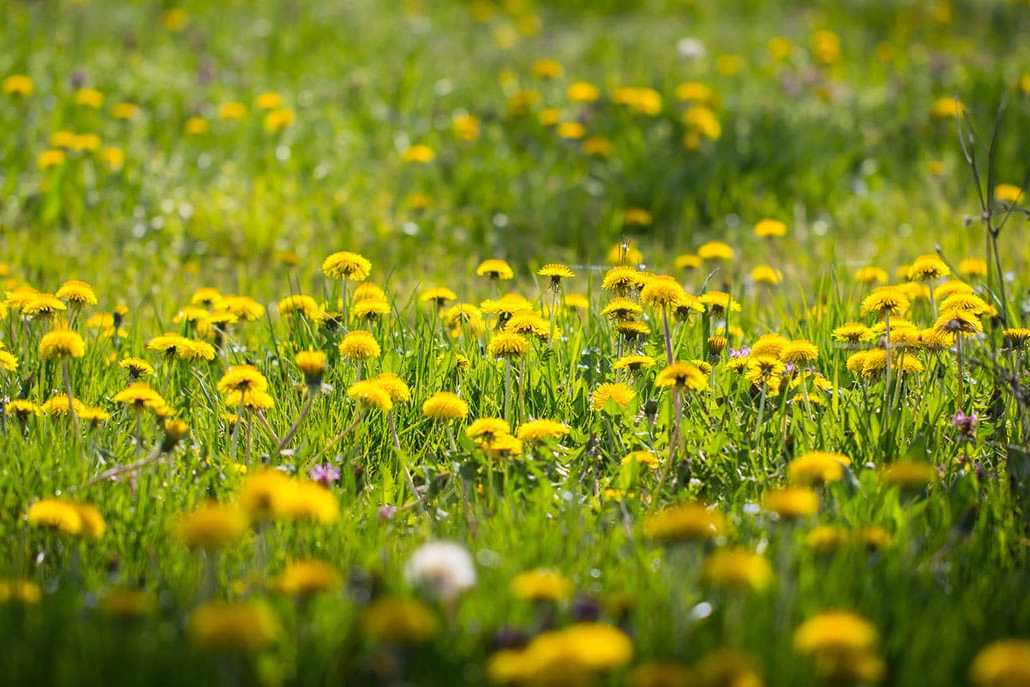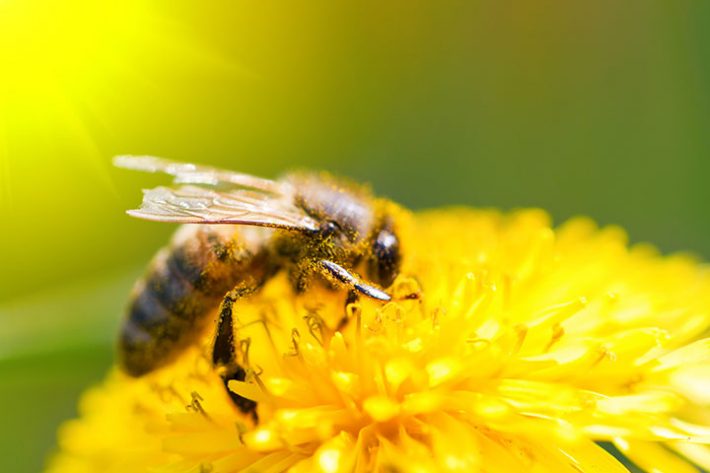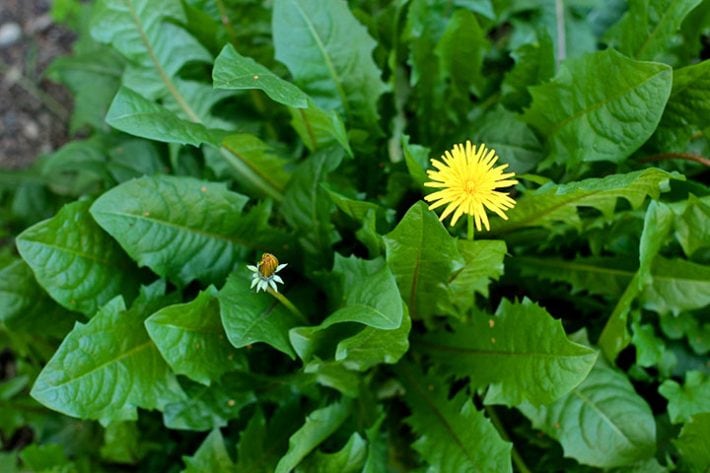
How to Make Dandelion Pesto (An Amazing Spring Tonic!)
One of my favorite weeks of the year is in April when the dandelions are out in full force. I am lucky enough to live in a rural area with lots of agriculture where there are giant meadows or even lawns where dandelions have permeated the grass. For one glorious week the dandelion’s yellow orbs cover entire fields like little medallions of golden coins.
Gazing out at those blazing yellow fields, I am in awe of the simple beauty while being simultaneously perplexed why anyone would want to poison dandelions!
More than 80 million pounds of herbicides are used on lawns, most specifically against dandelions, each year. Many of these chemicals either have not been tested for safety or have been shown to have a strong correlation with cancer.
Not only are these chemicals harmful to humans, they also affect the whole ecosystem, harming beneficial insects such as our bees.
That’s why it’s one of my personal missions in life to share my love of dandelions. The more people who love dandelion’s beauty as well as its food and medicine, the less people will want to poison it!
This dandelion pesto recipe focuses on making food out of the young dandelion leaves.
Dandelions Leaves Offer us Nutrients
Dandelion leaves are nutrient dense with lots of beta carotene, calcium and potassium. When researching my book Alchemy of Herbs, I was fascinated to find out that dandelion leaves (in addition to the roots) are high in inulin. Inulin is a starchy carbohydrate that provides food to our gut flora. Regularly eating foods high in inulin can help foster and diversify healthy gut bacteria that can affect many areas of health such as digestion and the immune system.
Herbalists primarily use the leaves as a diuretic. The French even commonly refer to it as “pissenlit,” which sounds pretty but literally translates to “pee the bed.”
The Sweet Side of Their Bitter Taste
Young dandelion leaves are a wonderful spring tonic as they offer lots of nutrition with a bit of bitter flavor. When your body detects bitterness, it helps stimulate lots of different stages of digestion, from increased saliva, which breaks down carbohydrates, to HCL in the stomach, to bile production and release, which helps to break down fats, to a variety of digestive enzymes. Many people are beginning to realize that the lack of bitter foods and drinks in our diet is an underlying cause for many of the rampant digestive issues we see today.
And while many people are using pills to replace digestive enzymes, I recommend adding bitter foods like dandelion to your diet regularly. In this way you are supporting your body’s natural production of digestive enzymes, instead of simply supplementing with exogenous sources.
We can see dandelion as not only an herb that can fix our health, but something that we need in order to simply maintain our good health! One thing to note is that, if harvesting your own dandelions, be sure to harvest in an area free from harmful chemicals.
How to Identify Dandelion
Being that dandelion (Taraxacum officinale) is a common weed that practically everyone recognizes, it may seem strange to include a section on identification, but there are some lookalikes. In case you are new to harvesting dandelions, here are some simple tips for making sure you’ve got the right plant.
Leaves: The leaves grow in a basal rosette and are smooth, lacking any significant hairs. (Many dandelion lookalikes have downy leaves or little prickles along the major vein on the underside of the leaf.) The leaves are simple, with jagged edges, and are commonly referred to as the “teeth of a lion.” The “teeth” on the leaves point back toward the center of the rosette. For this recipe you want to harvest young leaves. Older leaves will be too bitter to be palatable.
Flowers: The bright yellow flowers grow on a single leafless stem. (There are many dandelion lookalikes that have numerous yellow flowers on a single stem.) The flowers are a rich yellow color, as compared to the lighter yellow or darker orange of many lookalikes.
Roots: The roots grow as a single taproot, similar to a carrot. The roots are light brown or tan in color.
Distribution: Although dandelions occur in every state of the US, they are much less common in the southern tier of the country, where they do not readily tolerate the heat.
If you still aren’t sure if the plants around you are dandelions, find someone who can expertly identify the plant. You should always be 100% certain of the identification of the plant before you eat it or make a medicinal preparation with it.
If you aren’t up for foraging your own dandelion greens to make dandelion pesto, look for them at your grocery store in the produce section. Many stores will order them in when requested. (Note that the leaves at the grocery store are often from chicory, a closely related plant with many of the same qualities.)
Dandelion Pesto
This bitter dandelion pesto is tempered by the nutty, sweet flavor of pine nuts and the zing of lemon. I recently brought this to a potluck with about 50 people and I got countless compliments and requests for the recipe. I know your friends and family will love it, too. Besides the dandelion leaves, other ingredients in this recipe include “heart healthy” and inflammatory modulating ingredients like garlic, turmeric and olive oil. Serve with crackers, bread, or carrots. It’s also great as a topping on meats, veggies, and eggs.
What you’ll need…
- 1/2 cup shelled pine nuts
- 3 garlic cloves, minced
- 2 cups chopped fresh dandelion leaves, loosely packed
- 1 tablespoon lemon juice
- 1 tablespoon lemon zest
- 1/2 cup extra-virgin olive oil
- 1/2 teaspoon sea salt
- 1 teaspoon turmeric powder
- 1/2 teaspoon freshly ground black pepper
- 1/4 cup freshly grated Parmesan
1. Place all the ingredients except the Parmesan into a blender or food processor. Process until smooth. If it’s too thick, slowly add a bit more olive oil.
2. Add the Parmesan and continue to blend until the mixture has a smooth consistency.
3. Refrigerate, and eat within 3 days.
Yield: 2 cups
Recipe from Alchemy of Herbs: Transform Everyday Ingredients into Foods and Remedies That Heal by Rosalee de la Forêt (Hay House, 2017)
Now I’d love to hear from you!
Do you look forward to the dandelions each spring?
What are some of your favorite recipes?
Let me know in the comments below.












Love your article Rosalie. I’d like to share one of my favorite Springtime songs.
~~
I’m a happy little thing, always coming in the spring, in The Meadows green I’m found, peeping just above the ground, and my stock is covered Flat, with a fuzzy yellow hat…. Little children when you pass, lightly on the tender grass, skip along but do not tread, on my small and lowly head. I’m a flower that’s come to say, winter time has gone away.
~~
…..From my Waldorf singing group for young children, North Vancouver, BC
Love it! Thank you for sharing!
Mmmm that pesto looks SO delicious!!! I love dandelions and can’t wait ’til there up around here in Vermont.
They are also wonderful tossed with a hot vinaigrette salad dressing and fresh crushed garlic, topped with toasted chopped hazel nuts.
(I’ve tried growing them over winter in my hoop house, but the critters, voles and rabbits, love them so much they sneak in and eat them all up!)
The hot vinaigrette dish sounds delicious!
I have long appreciated dandelions for their fortitude, and ubiquitous yellow reminder of the sun, as if the green ground is saying: “We got ya’, sun. See us your tiny children reflecting your brightness back to you.”
This year, while weeding some raised beds, I saved the whole dandelion plant, cut off the leaves to give to our current pet bunny Coco, and then washed the roots for myself. I was pleasantly surprised to taste an almost sweet snack after I stir-fried the roots in coconut oil. I will do this much more regularly whenever we weed the beds. Dandy snack!
Rosalee, just want to tell you thanks for all of your wonderful info on herbs. You are a great lady for sharing!
We bought your book and are looking forward to learning from it. As for dandelions, we were happy to see that Sprouts store was selling the leaves. We are learning about dandelions and made a tincture from the roots too. We are so excited about this herbal learning adventure!
Ok, now I’m inspired… duck egg pasta with dandelion pesto… just waiting on Michigan spring!
I use dandelion as a diuretic to keep swelling in my lower legs and feet under control. I use the leaves as part of a salad, on sandwiches, and in teas. I have never tried dandelion wine, but have used tinctured dandelion as a tonic. For a change of pace I will shred dandelion leaves in a processor and add to the yolk mixture for deviled eggs. Sprinkle a tiny amount of cayenne pepper and watch them disappear!
Thank you Rosalee for sharing your knowledge with all of us. I ordered 6 copies of your book because there are at least that many people I know who would love to have a copy…or after they receive it they’ll come to love it!
I made the pesto tonight and it is really tasty. What a great way to introduce the edibleness of that queenly dandelion. I’m putting on a wine tasting tomorrow so I think I’ll take some and see which kind of wine it pairs well with.
Jennifer
Wow, 6 copies! Thank you! I’m curious which wine you chose to go with the pesto. I’m thinking a dry white…
Excellent info! I have alot to harvest and transform here in Texas!
Dandelions are probably my very favorite plant. I love the beautiful, cheerful blossoms and the fact that every part of the plaint is beneficial. I recently made dandelion pesto for the first time. My recipe was much like yours, but with toasted walnuts instead of pine nuts. It has become my favorite pesto.
I’ll have to try the Pesto I have always moved my dandelions in their own little garden when they pop up and wait until the flowers pop up and make wine or paint. I didn’t really think about eating the leaves because I know they are used as a diuretic.